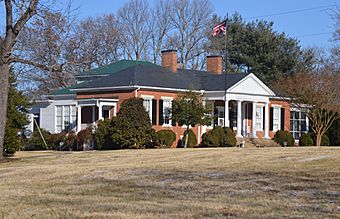Ampthill (Cumberland County, Virginia) facts for kids
|
Ampthill
|
|

Front, seen from the west
|
|
| Location | West side of VA 602, 3 miles (4.8 km) north of the junction with VA 45, Cartersville, Virginia |
|---|---|
| Area | 900 acres (360 ha) |
| Built | 1835 |
| Architectural style | Early Republic, Roman Revival |
| NRHP reference No. | 72001389 |
Quick facts for kids Significant dates |
|
| Added to NRHP | April 13, 1972 |
Ampthill is a historic home located in Cartersville, Virginia. It is about 45 minutes west of Richmond. This special property is listed on two important registers: the National Register of Historic Places and the Virginia Landmarks Register. These lists recognize places that are important to history.
Contents
Discovering Ampthill's Past
How the Land Became Ampthill
The story of Ampthill began in 1714. A man named Charles Fleming tried to claim 670 acres of land. He wanted to farm it. However, he did not follow all the rules. So, the land was later given to Thomas Randolph in 1722. This area was part of a much larger section of land. This larger section was known as "Clifton."
The original 670 acres were special. They were located where the James River and Willis River meet. This spot was called "The Fork." In 1724, Randolph sold this land. The buyer was Robert "King" Carter. He was the richest landowner in Virginia at that time.
The Harrison Family and Important Ideas
In 1726, King Carter wrote his will. He left the large 2870-acre property to his grandson. This grandson had to be named Carter. Later, Anne Carter and Major Benjamin Harrison had a son. They named him Carter Henry Harrison. He became the owner of the "Clifton" property. This was in Cumberland County, Virginia.
Carter Henry Harrison became a lawyer. After finishing law school, he moved to Clifton. He raised his family there. He also wrote something very important. It was called the Cumberland Resolutions. These ideas were shared with the community. They were later used to help create the United States Declaration of Independence. This famous document was written by Harrison's nephew, Thomas Jefferson.
Building Ampthill: A Special Design
Carter Henry Harrison passed away in 1793. In his will, he left "Clifton" to his son, Randolph. He left "The Fork" to his son, Robert. Robert sold "The Fork" in 1804. But Randolph bought it back in 1815. At that time, "The Fork" was a simple wooden house. It had only about three bedrooms.
In 1815, Randolph decided to add to the house. He asked his cousin, Thomas Jefferson, for help. Jefferson was a famous architect and president. He designed the brick part of the house you see today. These original plans are still kept at the University of Virginia. Construction on the new brick section began in 1835. It was finished in 1837. For some years, the old and new parts were separate. Later, a one-story hallway was built to connect them. After the brick addition was done, the house was renamed Ampthill.
Ampthill Through the Years
Over time, Ampthill changed owners many times. It even left the Harrison family in 1923. Different families bought and sold the property. This happened for many years. In 1952, the Rea family bought Ampthill. They lived there for a long time. In 1986, the Saunders family bought the home. They were actually related to the original Harrison family!
The Saunders family later moved. In 1998, George Costen bought the property. He started a big project in 1999. Ampthill went through a major historic restoration. This means it was carefully repaired and brought back to its original look. One of the old outbuildings was almost completely rebuilt. It had been used as a garage.
Ampthill Today
Today, Ampthill is a special place. It used to be a bed and breakfast. It is known for being the only privately owned home in Virginia designed by Thomas Jefferson. Its windows still have the original glass. Ampthill now sits on about 60 acres of land. This is part of the original 2870 acres. The property includes the main house and four smaller buildings. There is also a barn built in 1920. This barn is the newest building on the property.
See Also



